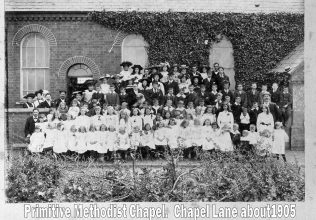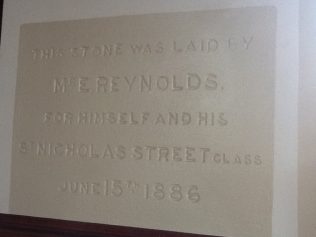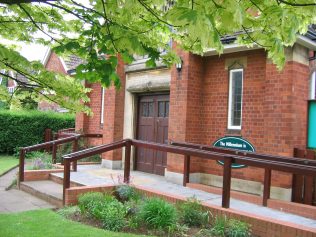Cosby: Primitive Methodism in Cosby
Leicestershire








Cosby is a village seven miles from Leicester. In July 1886, the PM Magazine reported that “till recently, the spiritual interests of the people had been much neglected. There was for years only occasional services at the Established Church, and Sunday evening services at the Baptist Chapel. Our call to the village was unmistakeable”. Two summers before, The Rev. J. Odell had conducted a camp meeting, but “for want of spiritual nurture, those who were awakened and converted became backsliders”.
No mention is made of the United Methodist Free Church, which existed in Cosby at the time that it was missioned. The plaque on the wall of what is now a private house dates this church from 1863.
The Rev. H Carden, Superintendent of the Leicester Second Circuit, secured a cottage room and formed a society, which increased three fold during the first six months. “A number of the worst characters in the village have been converted, amongst whom are several aged people – one man and his wife over 70 years of age”.
A site to build a chapel was purchased, and in July 1886 the foundation stones were laid. A service was conducted by the circuit ministers, and the Rev J. Odell gave the address. Nearly £90 was raised on the day of the stone laying.
Three months later, in October, the chapel was opened. It was “built in the Gothic style of architecture of ordinary red brick, windows and doorways being arched and tuck pointed”. At the inaugural service, the Rev J. H. Saxton of Leicester “preached 3 sermons to full and appreciative congregations’. The next day, there was an evening service when ‘Praise ye the Lord and a number of appropriate hymns were sung’ ”.
Chapel life was recorded by two sisters, Miss Nance and Miss Rose Gimson. “The week at the church was very full. Monday night was Christian Endeavour night, an active concert party practiced on Tuesday evenings, Wednesday was given over to the mid week devotional service, a preaching service led by the resident minister. Choir practice took place on Thursday, and Friday was concert or operetta practice night. Saturday night was social night but not every week – occasionally Saturday night was free!
Sunday was always very full with Sunday School all morning. In the afternoon the service was preceded by half an hour Sunday School, children then having to attend the whole service at the end of which it was a quick dash home for some tea before returning for the evening service at 6pm. After the evening service a prayer meeting was held. Not quite a day of rest for children, particularly those living some distance away from the chapel. On special Sundays and Easter Sunday the day began with an 8am communion service, so on those days the older children made the journey to the chapel four times”.
In 1909 a plot was purchased to build a “compact and happily situated” new chapel and schoolroom in the centre of the village, and in 1922, after 10 years of fundraising the foundation stones were laid. According to Nance and Rose “the building of the new chapel brought great excitement and expectation to the society, and much sacrifice. Children played in and ran round the foundations singing and shouting ‘this is ours, all ours’. The new chapel was opened on Saturday [in October 1922], the congregation meeting at the old chapel in Chapel Lane, and singing as they walked down to Park Road, ‘We’re marching to Zion, Beautiful, beautiful Zion. We’re marching to Zion, The beautiful city of God’.
The Rev. Claud Williamson was minister at the time, and services filled the new chapel with worshippers”.
The Miss Gimsons recall that camp meetings continued to be held once a year. “These comprised hymn singing at various points around the village, culminating in a service in Victory Park. A dray was used as a pulpit and forms were taken down to the park and set out for the congregation to use. These camp meetings were not enjoyed so much by some of the young people who hoped it would rain so that the service could be held inside the chapel as usual”.
Years of “financial strain” followed the opening of the chapel. In 1926 there remained an outstanding debt of £355, reduced to £182 in 1929. In 1936, the year of the 50th anniversary of the opening of the first chapel, the debt was finally paid off. At the Jubilee Celebrations, a speaker compared the cost of the two chapels: plot for the old chapel £19, for the new chapel £79-15-0: building the old chapel £359-2-7d, for the new £2686-12-0d: architect’s fee £17-10-0 compared with £75: oil lamps for the old chapel one guinea, power supply and electric lights for the new chapel £88-10 -0d. A second hand organ for the old chapel cost £12, the 2 manual Porritt organ for the new chapel £463-10-0d. The ‘lion’s share’ for the organ was contributed by Solomon Starmer, a local boot and shoe manufacturer.
Two memorial stones from the old chapel, bearing the names of Mr E. Jennings and Mr E. Reynolds, laid on behalf of themselves and their classes in St Nicholas Street Church Leicester, were built into the new chapel. After the St Nicholas St Church was demolished, when the Great Central Railway came through Leicester, the Hinckley Road PM church replaced it as head of the Leicester Second Circuit.
The date stone from the old chapel is built into the back end wall. In the schoolroom are named bricks, for which members paid 5 shillings. Nance and Rose Gimson’s widowed mother “made an enormous sacrifice and had a brick with Ethel Gimson written on it”, in memory of their older sister who died four weeks after the chapel was opened.
The earliest known record of Primitive Methodism in Cosby is on a South Leicester Circuit plan, dated July 1853. Cosby is listed as having two services on a Sunday and an evening service on alternate Thursdays, some marked S (sacrament), T (tickets), Q (quarterly collection), and CC (chapel or room collection). But of this early society and its meeting place, every trace seems to have been lost. What happened in the intervening years, until the revival of Primitive Methodism in the village in the 1880s?
Sources
Primitive Methodist Magazine July 1886
Leicester Advertiser October 16th 1886
Various information on the history of Cosby Methodist Church, collated by Mrs Dorothy Cooper, Senior Church Steward
Cosby Methodist Church Jubilee Celebration programme 1936





No Comments
Add a comment about this page